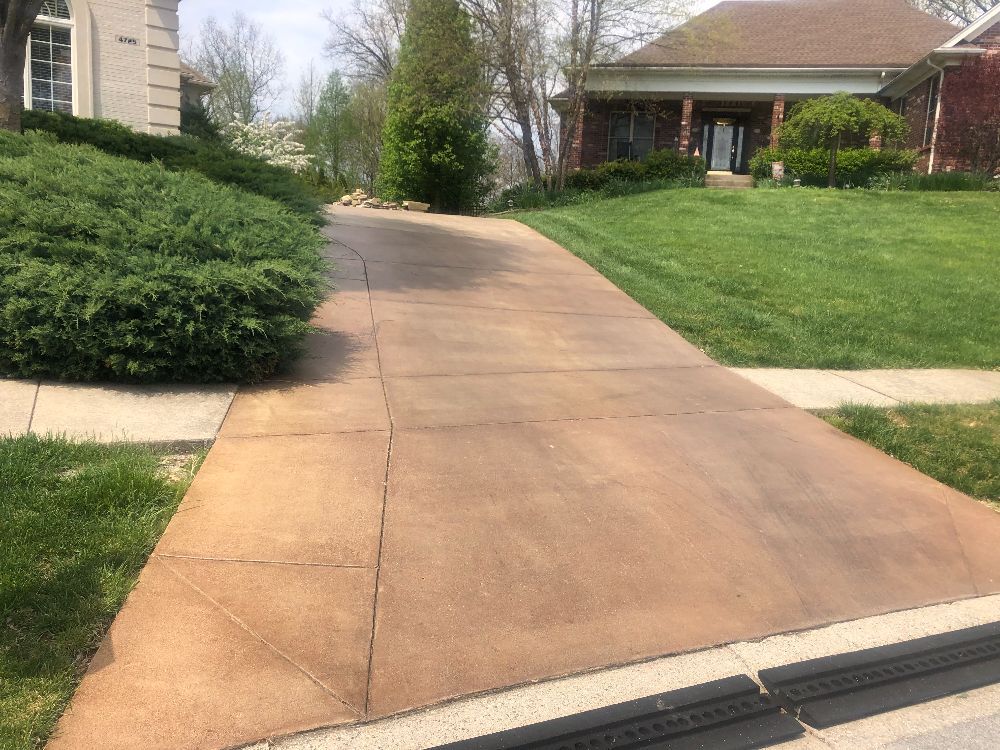
Wet-look sealer may look good, but that doesn't mean much if it's constantly slippery. Learn about how this concrete sealer may be dangerous if not used correctly.
If you’re looking for a way to enhance and protect the look and functionality of your concrete, you’ve most likely stumbled across wet-look concrete sealer, which is a smooth, shiny option that leaves concrete with a wet appearance.
However, boosting the aesthetics of your concrete and protecting it from damage doesn’t mean much if your concrete is at risk of being constantly slippery.
If you’re looking for a sealer to apply on top of standard brush-finished concrete, you live on a hill or steep slope, you have elderly loved ones with more risk of slipping and falling, and/or the area where you live is wet and icy frequently, wet-look concrete sealer might not be right for you.
Here at A-1 Concrete Leveling, our top priority is to protect and preserve our customers’ concrete while providing resources to help them learn as much as possible about the concrete repair and maintenance options available to them.
For this reason, we’ve compiled this article that will walk you through all you need to know about wet-look sealer’s slippery tendencies so that you can decide if it’s an option you would like to continue exploring for your home.
What is wet-look concrete sealer?
Wet-look concrete sealer is an acrylic-based topical sealer, meaning it sits on top of the concrete rather than penetrating into its pores.
This sealer is called “wet-look” because the goal is to give it a high shine and gloss, similar to if it were wet.
Wet-Look Concrete Sealer Can Make Surfaces Slippery
When the wet-look sealer is applied on top of the concrete, it can fill in the ridges and surface texture that add traction, which is designed to prevent the surface from becoming slippery.
Adding a wet-look sealer can make the finish get flatter, reducing its grit and affecting the tread. It’s similar to the process of applying nail polish to a fingernail. The polish stays on top, and it fills in any ridges or bumps in the nail, creating a smooth and shiny surface.
Walking on concrete with this type of topical sealer can be a major slip hazard. If wet, it can become even more dangerous, and this is especially true for concrete on slopes or with steep grades.
While this is true, in some cases, when a topical wet-look sealer is applied, sand can be thrown on top of the sealer before it is cured in order to provide a rougher, less slippery surface. This has some downsides, but it’s important to point out that it may be an option for some wet-look sealers.
Other Downsides to Wet-Look Concrete Sealer
Beyond the extra risk of slipping and falling due to wet-look concrete sealer, there are also some other downsides to be aware of when considering it as an option for your concrete.
For example, as it’s exposed to the sun, the UV rays can cause it to break down, and it can change to a yellow tint over time. It also has to be replaced more frequently than alternative options, like penetrating sealers.
If you’re planning on caulking the gaps and cracks in your concrete to help preserve it from further damage, it can be difficult to match the wet-looking concrete with a high-quality concrete caulk. In some cases, the sealer can also affect the longevity of the concrete caulk.
When is wet-look concrete sealer a good option?
Even though wet-look concrete sealer is slippery and comes with other downsides, there are some cases where it can work out if you’re really after the aesthetic:
- Your concrete isn’t sloped or sitting at the base of a hill where water drains
- Your concrete isn’t around water, like a pool deck
- You live in a more arid climate without lots of rain, snow, or ice
- You’re okay with the more-frequent maintenance and replacement needs
Wet-Look Concrete Sealer Alternatives
While wet-look concrete sealers sit on top of the concrete, their main alternatives are penetrating sealers. Penetrating sealers are absorbed into the concrete’s pores and react chemically with the concrete to create a barrier against moisture, deicing agents, and more.
Because penetrating sealers are absorbed into the concrete, the surface remains more or less the same as before the product was applied, aesthetically speaking. The grit and traction of the concrete also remain intact, so the surface won’t become slippery as a result of applying a penetrating sealer.
Now what?
Now that you’re equipped with more knowledge about wet-look concrete sealers, you’re even more prepared to decide if it’s an option you’re interested in exploring for the concrete around your home.
Here at A-1 Concrete Leveling, we’ve been protecting and preserving our customers’ concrete for over 30 years, and in this time we’ve gotten to know just how important it is that our customers know all the facts upfront so they can make informed decisions for their individual situations.
If you’re interested in learning more about what wet-look concrete sealer, penetrating sealer alternatives, or any other concrete maintenance or repair service can do for your home, click the link below to request a free onsite estimate!
Want to learn more? We have an extensive library for concrete repair and maintenance resources, including concrete sealing topics, called Concrete Academy. Check out some of these related articles:
Sarah Etler joined A-1 Concrete Leveling after receiving her Bachelor of Arts degree in English from Northern Kentucky University. As A-1's Content Marketing Manager, she works closely with industry experts to produce content that will best answer questions related to concrete repair and maintenance practices. Sarah loves living a life full of discovery and is excited every day to see what new things she can learn and share with those around her.